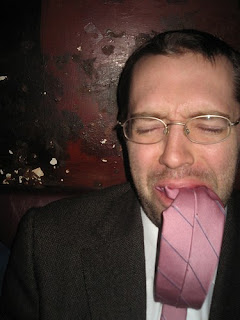This is slightly unfair for its generalism, but do you want to see where racism lives in America?
Take a look at what is my favorite election map so far (it's my favorite for two reasons, just one of which is racism). Click on "Voting Shifts" on the left, and just leave the "Compare to" button over 2004 for simplicity, and because the farther back you go the more and larger political variables you encounter. That is one ridiculously blue map. It shows how each county voted as compared to 2004. Things to remember when looking at the map:
1. Nationally, the number was red +2 in 2004, blue +6 in 2008, so on average those counties should be 8% redder in 2004 (or bluer in 2008).
2. Campaigning and thus exposure to both sides is hugely disproportionate to the battleground states, so those should have smaller swings.
3. Many states overall flipped red to blue in 08: VA, NC, FL, OH, IN, IA, NM, CO, NV, so these states should include bluer counties than other states on average.
4. Indiana and Arizona contain home-state advantages to consider. This is why Arizona holds 8 of the 10 counties to go more red in the entire Mountain and Pacific time zones, and also why Indiana is the bluest state on the whole map.
So, absorbing all that, what does the map tell us, besides the obvious and instant fact that the Democrat did much better this time? Or, given the 8 point swing from 2004, plus the more inclusive nature of this campaign's advertising, leaving us to expect a generally bluer map all over, what would be the reason for the clustered deep red on the map?
John McCain received his greatest disparity of support over what Bush received primarily in one congruent area of the country centered over Arkansas but running from East Texas and Oklahoma across Tennessee and up into Eastern Kentucky and far western Virginia and West Virginia. The national vote (from D perspective) went from -2 to +6, but Arkansas managed to go from -10 to -20. Softening the national swing because Arkansas is a deep Republican state, we still should have expected something more like -6 for the Democrat this time, not -20, and that is a huge difference.
Outside of this corridor of increased Rep support, look at one of the blue flip states, Ohio. As I said before, we might expect some of the margins in this massive battleground state to be smaller than nationally; however, the vote there almost exactly mirrored the national in 04 and 08: -2 and +4. So why did 13 of its 88 counties vote more red in this election? Those 13 mostly reside in southern or eastern parts of the state.
I think it's clear that there is one possible answer to all of these questions, the one I mentioned at the beginning: racism. It's always controversial to accuse people of racism but sometimes the truth is hard, and problems will never be overcome if they are kept hidden. (I'm obliged to say that I'm no expert on local politics of the Ozarks, so there might be some mitigating factor that causes the region to buck the national trend. My perhaps lazy conclusion just seems fairly likely. At the very least, it's a large part of the whole answer.)
The other striking thing about the map is how it illustrates the comprehensive nature of Obama's performance relative to Kerry. As per my usual, I'll use numbers: 22 states saw every single one of their counties with increased Democratic numbers. Four more had all but one county, and three additional had only two counties show Republican increases. 29 out of 50 states had two of fewer counties give more support to Republicans. That's amazing. It wasn't just pockets of strength that gave the Democrats the edge, it was across the board. That would be ominous news for Republicans. They better hope that most Americans view Obama as a transcendent figure and crossed idealogical lines just to vote for him personally, rather than his party.
Thursday, November 6, 2008
Subscribe to:
Post Comments (Atom)


No comments:
Post a Comment